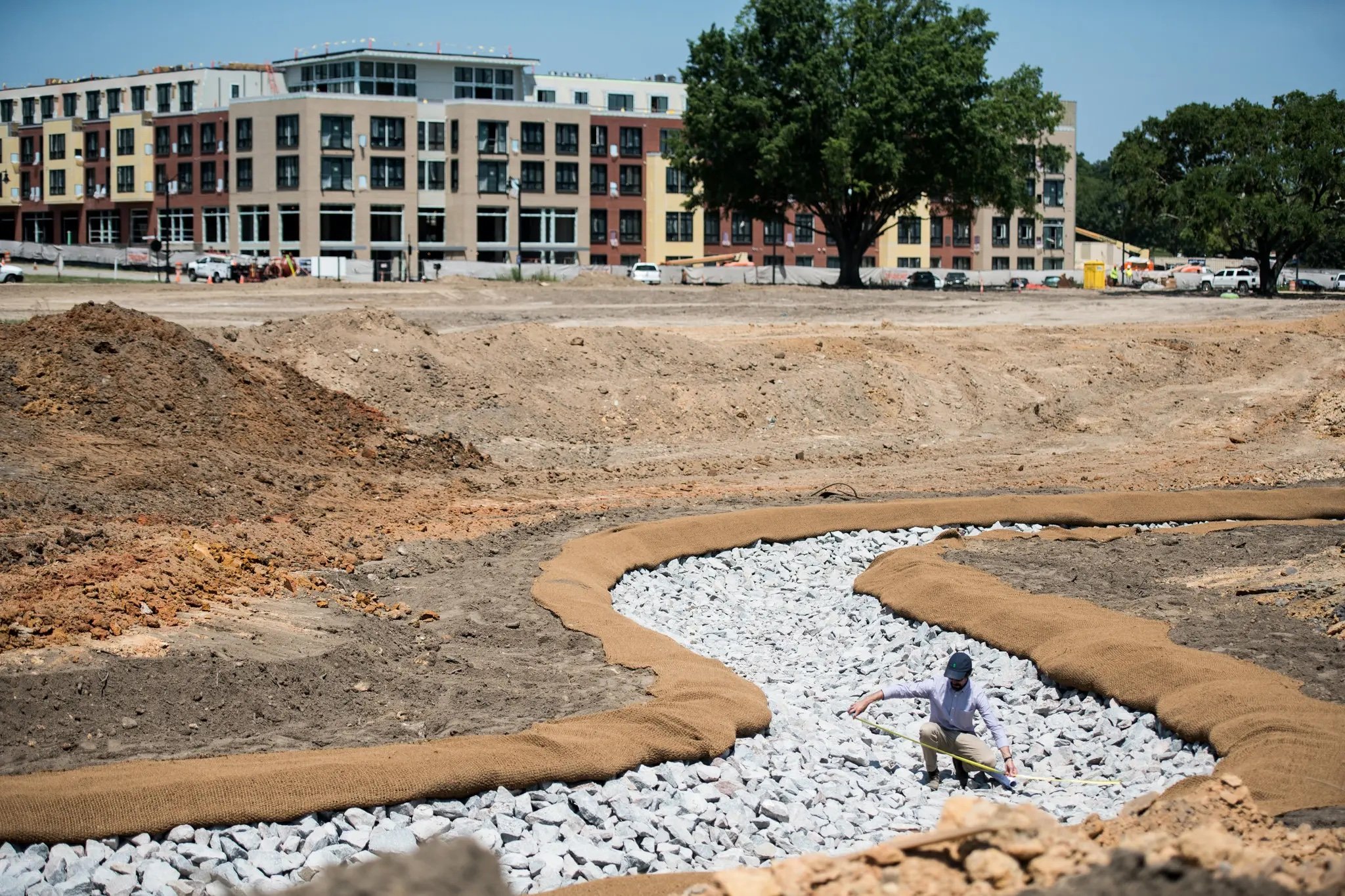From Former Mental Hospital to Recreational Hub
Since 2014, RDE has worked with the Hughes Development Corporation and the City of Columbia, SC to naturalize and “daylight” Smith Branch, a creek that flows through the site of the historic state mental hospital. Quoting from a recent article about the project in the New York Times:
Sean Rayford for The New York Times
The South Carolina Lunatic Asylum admitted its first patient in 1828. Ever since, its impressive brick wards surrounded by nearly 200 acres of leafy lawns and gardens served as landmarks in Columbia, the state’s capital.
Almost 200 years later, and three decades after the last patient was discharged, the old brick buildings and expansive open space are being steadily converted into one of the largest downtown mixed-use real estate projects in the nation, a 181-acre development known as the BullStreet District…
More than $100 million has been invested to construct an inviting downtown destination that Columbia has never had before. BullStreet is steadily emerging as the civic space that Stephen K. Benjamin, the city’s three-term mayor, envisioned when he persuaded the City Council in 2013 to begin collaborating on the project with the Hughes Development Corporation, a developer based 100 miles away in Greenville…
Hughes is also constructing a $4 million, 20-acre park, which features restoring the natural flow of Smith Branch, a tributary of the Broad River that runs through the site. Before Hughes took ownership of the development, the creek flowed for 1,000 feet above ground, and then disappeared for 1,600 more feet into two mammoth underground concrete pipes the state installed in the 1950s to control flooding.
“Joshua Robinson, an engineer and hydrologist from Charleston, designed a restoration plan to clear the first 1,000 feet of debris and rebuild the existing channel. He then constructed 1,600 feet of new channel on the surface, freeing the creek from the pipes. Mr. Robinson did not demolish the old pipes, though. He left them in place and built a concrete weir, a compact dam structure that during storms diverts high flows into the pipes and protects the park from floods.
“The stream is the spine of the park,” said Mr. Robinson, who expects to open the park later this year. Upstream will be the most naturalistic part of the park with native vegetation. Downstream will have manicured fields and walking paths, a two-acre pond, pools and shade trees. “It will be a diverse experience, feel natural, and all in human scale,” he said.
Givens Estates completes its innovative stormwater project
Since 2008, RDE has provided consulting, planning, and design services to Givens Estates, 200-acre United Methodist Retirement Community in Asheville. We first led a campus-wide masterplanning effort that includes a prioritized schedule of projects, capital improvements, and housekeeping measures to reduce stormwater flooding, improve the quality of the three mountain streams flowing through the campus, and strengthen the institutional efforts toward ecological restoration throughout the campus.
In 2016, Givens and local non-profit RiverLink were awarded an Innovative Stormwater Management grant from the NC Clean Water Management Trust Fund. RDE collaborated with RiverLink to submit the grant, providing the technical data and supporting information. We recently completed construction of the project; the press release by RiverLink was published by Mountain Xpress and is included below.
In-stream structures, built by hand with logs and stones, slow high velocity flow and prevent pollutant sediment from flowing downstream to Dingle Creek and the French Broad River.
Press release from RiverLink:
Construction is now complete on the Givens Estates Innovative Stormwater Project. Funded by a $166,975 grant from the N.C. Clean Water Management Trust Fund, in conjunction with $359,468 in matching funds from Givens Estates and RiverLink, the project constructed retrofits to six stormwater control measures (SCMs) on the Givens Estates campus, a Methodist retirement community in South Asheville.
The SCMs will capture runoff from Givens Estates, preventing sediment from entering Dingle Creek, a major tributary to the French Broad River. Sediment—the number one pollutant in the French Broad River—is a priority for RiverLink due to its ability to carry pollutants throughout the watershed and harm aquatic organisms such as fish and the threatened hellbender salamander.
The innovative aspect of the project is the research being conducted by RiverLink and Robinson Design Engineers to determine how effective the SCMs are at capturing sediment. The majority of stormwater research in North Carolina has occurred in the Piedmont and Coastal Plain regions. The results of this study will help set the design standards for stormwater control measures in the steep slopes of Western North Carolina. Preliminary data is promising, with 4.5 tons of sediment captured by the SCMs in the first post-construction rain event.
The project was a collaborative effort with Robinson Design Engineers providing design and research services, NC State University Minerals Lab offering in-kind donation of sediment sample analysis, and Miller Brothers Inc providing construction services. In addition, 633 hours of community service was provided by RiverLink volunteers and 710 native plants were installed in the SCMs.
RiverLink’s Watershed Resources Program works to improve water quality and quantity within the French Broad River watershed in Western North Carolina. The program utilizes a multi-faceted approach including grant-funded projects that mitigate stormwater runoff, restore degraded aquatic and riparian habitats, and create watershed plans, along with education initiatives that raise awareness and empower citizens to improve regional water quality.
Since 1987 RiverLink has worked with local citizens, community leaders and businesses to address the environmental and economic health of the French Broad River Basin. The organization is a key player in revitalizing the riverfront district, providing recreational and educational amenities for citizens and visitors, and promoting conservation and environmental education initiatives.
For more information on the Givens Estates Project contact:
Renee Fortner, Watershed Resources Manager renee@riverlink.org (828) 252-8474 X 14.
For general information about RiverLink, including upcoming events, projects, and ways to give visit www.riverlink.org.
Charleston property owners can be more engaged in managing flood, drainage resources
We recently spoke with David Quick at the Post & Courier about rain gardens, rainwater harvesting, and water management for Charleston area homeowners. Read the article here.
Photo credit: Post & Courier
Tupelo Bend’s Grand Opening
This week we stopped by the grand opening of Tupelo Bend, a low-impact development commercial office park that we planned and designed in collaboration with our good friend Dave Merrifield of Holden Design Shop. Owners and developers New Leaf Builders imagined the office park to be more like a neighborhood, with four buildings resembling homes instead offices.
The undeveloped site was typical of the natural Lowcountry landscape, with numerous grand trees and a freshwater wetland. These natural features served as our design inspiration for the office park, and the site plan was developed to work with the existing landscape and natural resources. The office park was named “Tupelo Bend” in honor of the native tupelo trees within the wetland and the entrance road that was designed to bend around the existing trees and wetlands.
Following the original drainage patterns of the landscape, we designed a series of inter-connected bio-retention basins. This distributed stormwater management system creates a functional landscape of shallow depressions, swales, and vast areas of native vegetation that store, treat, and use stormwater runoff. A beautifully-crafted pedestrian bridge crosses the central bio-retention basin, creating a unique, serene arrival experience to the offices of New Leaf Builders and their neighbors.
Experts devising ways to make stormwater ponds more natural, functional
Joshua Robinson recently spoke with David Quick at the Post & Courier about stormwater bioretention, constructed wetlands, and pond naturalization retrofits. Read the full article here.
Photo by David Quick, Post & Courier
A Neighborhood Built not to Flood
In 2012 we worked with New Leaf Builders to create Fox Hollow, an infill neighborhood on James Island. Thanks to SC Public Radio and journalist Alexandra Olgin for the chance to talk about the low impact development approach and stormwater wetlands at Fox Hollow. This piece is part of a larger conversation about the October 2015 floods and what they’ve shown us about stormwater management and sea level rise in coastal South Carolina.
Paddling Gadsden Creek
On May 16, 2015, four friends paddled the majority of Gadsden Creek, the last remaining tidal creek in Charleston's Old City District, on an urban expedition. The four embarked from the upstream end of Section II, located at Line Street and Hagood Avenue, and paddled to the end of Section IV, terminating at Lockwood Boulevard.
Best New Community
Fox Hollow, our recent low-impact development neighborhood on James Island, has received a 2013 Prism Award by the Charleston Home Builders Association. Congratulations to New Leaf Builders, and many thanks for the opportunity!

















